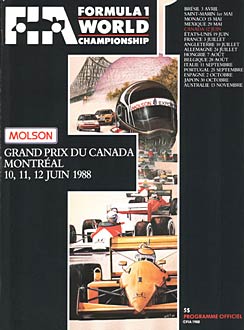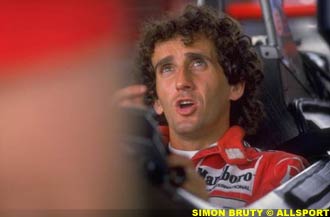| ATLAS F1 Volume 6, Issue 24 | |||
 |
A Race to Remember | ||
| by Roger Horton, England | |||
|
Every Grand Prix Venue has its most remembered race; that race where the mighty gods of Formula One diced and dodged to achieve eternal greatness and set the record books straight. But every Grand Prix venue also has remarkable races that were pushed aside in the history books, for no good reason. Atlas F1 reviews, ahead of every Grand Prix this season, one race which should be memorised and valued; that one round in history which makes a Race to Remember
For some reason the Canadian Grand Prix seems to regularly serve up more than its fair share of interesting races, many of which have rightly taken their place in motor racing folklore. Some of these races have featured the magic of the Villeneuve name. Gilles Villeneuve becoming the first Canadian driver to win his home event in 1978, sending thousands of his countrymen home delirious with delight. To date his son Jacques has failed to follow in his father's footsteps, a second place finish in the '96 event being his best result so far in Canada.
The start at Montreal is also almost guaranteed to jangle the nerves and cause at least one driver to make the lonely walk back to the pits to explain to an angry team boss just what happened and why he was the innocent party. The '98 event required three starts to see the cars on their way, whilst last year Jarno Trulli and Jean Alesi managed to eliminate themselves with a few seconds of the start (for the second race in a row).
Perhaps the timing of the event can offer some clue for some of these dramas. At almost the half way point in the season the battle for the titles always seems to come into sharp focus. The need for points is more urgent and the opportunities to make up the lost ground are receding fast.
But sometimes, looking back with the benefit of hindsight, events that happened take on a different meaning. Just as the first flash of lightning is so often the prelude to a storm, so the first shots of what was to become F1's most bitter 'driver against driver' war were fired off in the Canadian Grand Prix of 1988.
Before the race
The 1988 season was all about the Honda-powered McLarens of Ayrton Senna and Alain Prost. Going into the Canadian Grand Prix the team had won all four events it had so far contested. They led their nearest rivals Ferrari 48 - 27 in the contest for the constructors' cup. Honda was the only engine manufacturer prepared to spend the huge amount of money required to cope with the new rule requirement, which limited the Turbo engines to just 150 litres of fuel, in this, the last year that Turbo engines would be allowed.
So far the season had favored the more measured and controlled approach of the Frenchman. He held an almost crushing 33 - 18 points lead over his Brazilian rival, having won three races to one. Going into this race Senna was determined to turn things around. Yet another loss would perhaps see his teammate amass a point's advantage that even he could not redress.
Qualifying was a repeat of what had gone before, Senna taking his fifth straight pole position of the season, with Alain Prost alongside. Behind them were the Ferraris of Gerhard Berger and Michele Alboreto, their main turbo powered rivals. On the third row was the Benetton of Alessandro Nannini, who, together with his teammate Thiery Boutsen, was their only serious normally aspirated challengers. The Benettons, unlike the Turbos, could feed their Ford DFR engines all the fuel they needed from their 215 litre tanks.
The warm-up produced the first shock of the weekend when a McLaren Honda failed to register the fastest time, just maybe the Turbos would struggle in the long race ahead, it would prove to be a forlorn hope.
At the pre-race driver's briefing Senna demanded an explanation from the organisers as to why, as the pole sitter, he was on the right hand side of the circuit when the first corner was a left-hander. No, came the answer, the first left-hander was a curve, not a corner, and the first corner turned to the right. An unhappy Senna went to the start sure that he would be unable to benefit from his pole position and so it proved, as Prost's McLaren made a better getaway from the cleaner side of the grid and held the inside line when it mattered.
The Race
The two Mclarens led the field easily, pulling away from the Ferraris of Berger and Alboreto, and ahead of the two Benettons, who were looking good - unlike the cars in front the Benetton drivers could race flat out without the need to constantly monitor their fuel consumption.
Once in front Senna was able to build his lead, mostly through the decisive way he was able to lap the tail enders. Prost, more circumspect, could match his teammate's pace on a clear track, but not the way he made the gaps through the traffic appear, rather than waiting for the gaps to open up as the backmarker became aware of his presence.
Soon both Ferraris had retired and it was left to the Benetton of Boutsen to chase the McLarens. This he did, eventually coming home some 55 seconds behind the winner Senna, who finished the race with a six-seconds advantage over his teammate.
This Canadian race also provided one of mysteries that can make the sport of motor racing both fascinating and sometimes frustrating. Officially, Berger's Ferrari retired with electrical problems, but the actual reason would remain a mystery for some years, and perhaps the full story will never be known. All through the race weekend Berger's car suffered from a misfire. Despite an engine change it could not be cured and it got so bad in the race that he was forced to retire the car. When the car was returned to base it was tested untouched at Fiorano and ran perfectly.
In Canada Alboreto's identical sister car ran without trouble through practice and qualifying, although it retired in the race with an engine problem. Now when the teams arrived at the Montreal track the new pits and garage complex were not quite ready and the power supply needed to be augmented by a portable generating plant. The Ferrari pit was closest to this generator and of the two Ferraris Berger's was adjacent to it. In the end it was Ferrari's best guess that somehow Berger's engine management system was affected by the close proximity of the generator and that caused the misfire!
Nelson Piquet finished fourth in his Turbo powered Lotus a lap down, but well ahead of the March-Judd of Ivan Cappelli.
In many ways Derek Warwick in his Arrows was the true hero of this event. The Briton had survived a massive practice crash during qualifying and was taken from the circuit's medical center to a hospital in Montreal for a check up. Electing to race despite still feeling the effects of his high-speed accident he persevered to finish in seventh place, but had to be assisted out from the cockpit at the end of the race.
Conclusion
When the dust settled on the 1988 Canadian Grand Prix it appeared to have been a pretty straightforward race. It saw the first lead change on track so far that season, and Ayrton Senna aggrieved by the 'powers that be' over the location of pole position on the track and not for the last time. When he lost a similar argument at Suzuka some two and a half years later, he would remedy the situation by the simple expediency of ramming the 'offending' driver - once again Alain Prost - off the track after once again being beaten into the first corner.
Many more times we would see Senna win through his extraordinary skill and commitment in lapping slower cars. Finally, at Suzuka, Japan, in 1989, we would see Prost cry enough and close the door when Senna again attempted to muscle his way past, a rather surprising and clumsy maneuver for such an accomplished driver. If these events flowered at Suzuka in Japan, they had their seeds at Canada in '88 with much watering of the growing feud in between.
|
| Roger Horton | © 2000 Kaizar.Com, Incorporated. |
| Send comments to: horton@atlasf1.com | Terms & Conditions |
 In recent years the race in Montreal has continued to throw up surprises and controversies. Just what odds would you have got prior to the start of last year's race if you had suggested that no less than three world champions would crash out of the race in almost identical fashion? Yet that's exactly what happened, as Jacques Villeneuve, Damon Hill and Michael Schumacher all 'parked' their cars against the concrete barrier opposite the pits after losing control of their cars.
In recent years the race in Montreal has continued to throw up surprises and controversies. Just what odds would you have got prior to the start of last year's race if you had suggested that no less than three world champions would crash out of the race in almost identical fashion? Yet that's exactly what happened, as Jacques Villeneuve, Damon Hill and Michael Schumacher all 'parked' their cars against the concrete barrier opposite the pits after losing control of their cars.

